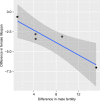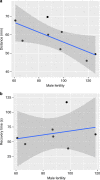Intralocus sexual conflict can resolve the male-female health-survival paradox
- PMID: 30487539
- PMCID: PMC6261961
- DOI: 10.1038/s41467-018-07541-y
Intralocus sexual conflict can resolve the male-female health-survival paradox
Abstract
At any given age, men are more likely to die than women, but women have poorer health at older ages. This is referred to as the "male-female, health-survival paradox", which is not fully understood. Here, we provide a general solution to the paradox that relies on intralocus sexual conflict, where alleles segregating in the population have late-acting positive effects on male fitness, but negative effects on female health. Using an evolutionary modelling framework, we show that male-benefit, female-detriment alleles can spread if they are expressed after female reproduction stops. We provide support for our conflict based solution using experimental Drosophila data. Our results show that selecting for increased late-life male reproductive effort can increase male fitness but have a detrimental effect on female fitness. Furthermore, we show that late-life male fertility is negatively genetically correlated with female health. Our study suggests that intralocus sexual conflict could resolve the health-survival paradox.
Conflict of interest statement
The authors declare no competing interests.
Figures



References
-
- Alberts, S. C. et al. in Sociality, Hierarchy, Health (eds Weinstein, M. & Lane, M. A.) Ch. 15 (National Academies Press, Washington, D.C, 2014). - PubMed
Publication types
MeSH terms
LinkOut - more resources
Full Text Sources
Other Literature Sources
Molecular Biology Databases

